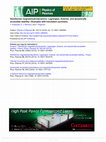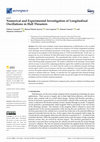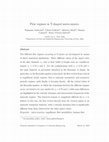Papers by Tommaso Andreussi
An axisymmetric magnetohydrodynamics ͑MHD͒ model of the acceleration channel of an applied-field ... more An axisymmetric magnetohydrodynamics ͑MHD͒ model of the acceleration channel of an applied-field magnetoplasmadynamic thruster is presented. A set of general relationships between the flow features and the thruster performance is obtained. The boundary conditions and the flow regime, which depends on the Alfvén Mach number, are shown to provide the ideal limits of steady state thruster operation. In the present analysis, a Hamiltonian formulation of the MHD plasma flow model is adopted. This formulation makes it possible to cast the model equations in a variational form, which is then solved by using a finite element numerical algorithm.
A Hamiltonian formulation of the MHD plasma flow equations in terms of noncanonical variables is ... more A Hamiltonian formulation of the MHD plasma flow equations in terms of noncanonical variables is briefly discussed for the case of stationary axisymmetric configurations. This formulation makes it possible to cast these flow equations in a variational form with mixed (closed and/or open) boundary conditions. Within this framework the modelling of the acceleration channel of an applied-field Magneto-Plasma-Dynamic (MPD) thruster for space propulsion is discussed and shown to provide general relationships between the flow features and the thruster performance.

In Hall propulsion, the thrust is provided by the acceleration of ions in a plasma generated in a... more In Hall propulsion, the thrust is provided by the acceleration of ions in a plasma generated in a cross-field configuration. Standard thruster configurations have annular channels with an almost radial magnetic field at the channel exit. A potential difference is imposed in the axial direction and the intensity of the magnetic field is calibrated in order to hinder the electron motion, while leaving the ions non-magnetised. Magnetic field lines can be assumed, as a first approximation, as lines of constant electron temperature and of thermalized potential. In typical thruster configurations, the discharge occurs inside a ceramic channel and, due to plasma-wall interactions, the electron temperature is typically low, less than few tens of eV. Hence, the magnetic field lines can be effectively used to tailor the distribution of the electrostatic potential. However, the erosion of the ceramic walls caused by the ion bombardment represents the main limiting factor of the thruster lifetime and new thruster configurations are currently under development. For these configurations, classical first order models of the plasma dynamics fail to grasp the influence of the magnetic topology on the plasma flow. In the present paper, a novel approach to investigate the correlation between magnetic field topology and thruster performance is presented. Due to the anisotropy induced by the magnetic field, the gradients of the plasma properties are assumed to be mainly in the direction orthogonal to the local magnetic field, thus enabling a quasi-one-dimensional description in magnetic coordinates. Theoretical and experimental investigations performed on a 5 kW class Hall thruster with different magnetic field configurations are then presented and discussed.

The different flow regimes occurring in T-mixers are investigated by means of direct numerical si... more The different flow regimes occurring in T-mixers are investigated by means of direct numerical simulations. Three different values of the aspect ratio of the inlet channels, Ä i , that is their width to height ratio are considered, namely Ä i = 0.75, 1 and 2. For the configurations with Ä i = 0.75 and 1, the same behavior as previously described in the literature, is found. In particular, as the Reynolds number is increased, the flow evolves from vortical to engulfment steady regimes, then to unsteady asymmetric and symmetric periodic regimes, until, finally, it becomes chaotic. All the critical values of the Reynolds number, at which the transitions between the different regimes occur, are found to be very similar for Ä i = 0.75 and 1, while some differences are highlighted in the vorticity dynamics and characteristic frequencies of the unsteady regimes. The observed scenario is completely different for Ä i = 2. Indeed, in this case, the flow evolves directly from the vortical regime to an unsteady symmetric behavior, with a vorticity dynamics that is significantly different from those observed for the other aspect ratios.
The chain rule for functionals is used to reduce the noncanonical Poisson bracket for magnetohydr... more The chain rule for functionals is used to reduce the noncanonical Poisson bracket for magnetohydrodynamics (MHD) to one for axisymmetric and translationally symmetric MHD and hydrodynamics. The procedure for obtaining Casimir invariants from noncanonical Poisson brackets is reviewed and then used to obtain the Casimir invariants for the considered symmetrical theories. It is shown why extrema of the energy plus Casimir invariants correspond to equilibria, thereby giving an explanation for the ad hoc variational principles that have existed in plasma physics. Variational principles for general equilibria are obtained in this way.

Because different constraints are imposed, stability conditions for dissipationless fluids and ma... more Because different constraints are imposed, stability conditions for dissipationless fluids and magnetofluids may take different forms when derived within the Lagrangian, Eulerian (energy-Casimir), or dynamically accessible frameworks. This is in particular the case when flows are present. These differences are explored explicitly by working out in detail two magnetohydrodynamic examples: convection against gravity in a stratified fluid and translationally invariant perturbations of a rotating magnetized plasma pinch. In this second example, we show in explicit form how to perform the time-dependent relabeling introduced in Andreussi et al. [Phys. Plasmas 20, 092104 (2013)] that makes it possible to reformulate Eulerian equilibria with flows as Lagrangian equilibria in the relabeled variables. The procedures detailed in the present article provide a paradigm that can be applied to more general plasma configurations and in addition extended to more general plasma descriptions where dissipation is absent. Published by AIP Publishing.

Stability conditions of magnetized plasma flows are obtained by exploiting the Hamiltonian struct... more Stability conditions of magnetized plasma flows are obtained by exploiting the Hamiltonian structure of the magnetohydrodynamics (MHD) equations and, in particular, by using three kinds of energy principles. First, the Lagrangian variable energy principle is described and sufficient stability conditions are presented. Next, plasma flows are described in terms of Eulerian variables and the noncanonical Hamiltonian formulation of MHD is exploited. For symmetric equilibria, the energy-Casimir principle is expanded to second order and sufficient conditions for stability to symmetric perturbation are obtained. Then, dynamically accessible variations, i.e., variations that explicitly preserve invariants of the system, are introduced and the respective energy principle is considered. General criteria for stability are obtained, along with comparisons between the three different approaches. V

Aerospace
One of the main oscillatory modes found ubiquitously in Hall thrusters is the so-called breathing... more One of the main oscillatory modes found ubiquitously in Hall thrusters is the so-called breathing mode. This is recognized as a relatively low-frequency (10–30 kHz), longitudinal oscillation of the discharge current and plasma parameters. In this paper, we present a synergic experimental and numerical investigation of the breathing mode in a 5 kW-class Hall thruster. To this aim, we propose the use of an informed 1D fully-fluid model to provide augmented data with respect to available experimental measurements. The experimental data consists of two datasets, i.e., the discharge current signal and the local near-plume plasma properties measured at high-frequency with a fast-diving triple Langmuir probe. The model is calibrated on the discharge current signal and its accuracy is assessed by comparing predictions against the available measurements of the near-plume plasma properties. It is shown that the model can be calibrated using the discharge current signal, which is easy to measu...
AIAA Propulsion and Energy 2019 Forum
Plasma Physics and Controlled Fusion

Computers & Chemical Engineering, 2015
The different flow regimes occurring in T-mixers are investigated by means of direct numerical si... more The different flow regimes occurring in T-mixers are investigated by means of direct numerical simulations. Three different values of the aspect ratio of the inlet channels, κ i , that is their width to height ratio are considered, namely κ i = 0.75, 1 and 2. For the configurations with κ i = 0.75 and 1, the same behavior as previously described in the literature, is found. In particular, as the Reynolds number is increased, the flow evolves from vortical to engulfment steady regimes, then to unsteady asymmetric and symmetric periodic regimes, until, finally, it becomes chaotic. All the critical values of the Reynolds number, at which the transitions between the different regimes occur, are found to be very similar for κ i = 0.75 and 1, while some differences are highlighted in the vorticity dynamics and characteristic frequencies of the unsteady regimes. The observed scenario is completely different for κ i = 2. Indeed, in this case, the flow evolves directly from the vortical regime to an unsteady symmetric behavior, with a vorticity dynamics that is significantly different from those observed for the other aspect ratios.

Physics of Plasmas, 2013
ABSTRACT Stability conditions of magnetized plasma flows are obtained by exploiting the Hamiltoni... more ABSTRACT Stability conditions of magnetized plasma flows are obtained by exploiting the Hamiltonian structure of the magnetohydrodynamics (MHD) equations and, in particular, by using three kinds of energy principles. First, the Lagrangian variable energy principle is described and sufficient stability conditions are presented. Next, plasma flows are described in terms of Eulerian variables and the noncanonical Hamiltonian formulation of MHD is exploited. For symmetric equilibria, the energy-Casimir principle is expanded to second order and sufficient conditions for stability to symmetric perturbation are obtained. Then, dynamically accessible variations, i.e. variations that explicitly preserve invariants of the system, are introduced and the respective energy principle is considered. General criteria for stability are obtained, along with comparisons between the three different approaches.
ABSTRACT A Hamiltonian formulation of the MHD plasma flow equations in terms of noncanonical vari... more ABSTRACT A Hamiltonian formulation of the MHD plasma flow equations in terms of noncanonical variables is briefly discussed for the case of stationary axisymmetric configurations. This formulation makes it possible to cast these flow equations in a variational form with mixed (closed and∕or open) boundary conditions. Within this framework the modelling of the acceleration channel of an applied‐field Magneto‐Plasma‐Dynamic (MPD) thruster for space propulsion is discussed and shown to provide general relationships between the flow features and the thruster performance.

Uploads
Papers by Tommaso Andreussi